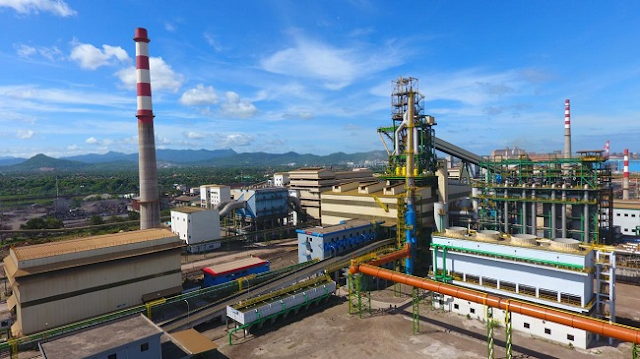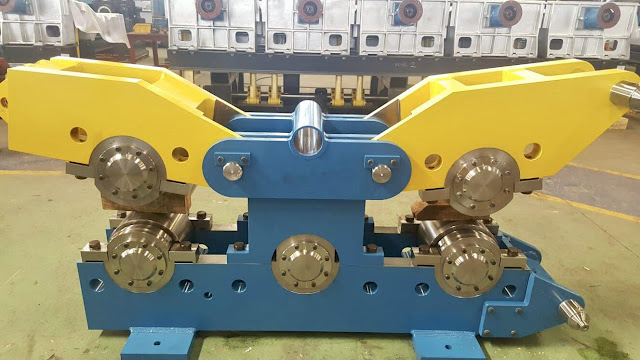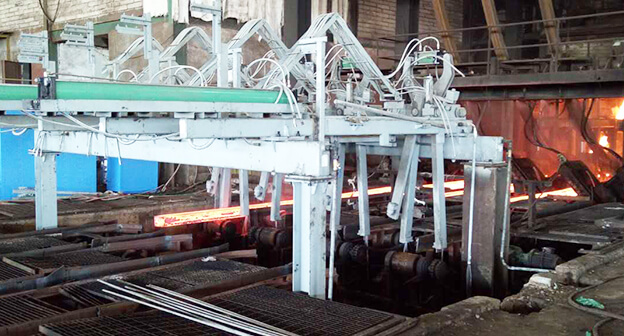The treatment scheme is as follows:
● Organize slag and iron out, prepare to stop air and replace it.
● In order to reduce the leakage of water into the furnace, the wind should be reduced to strive for a bright tuyere before the wind is stopped, so as to prevent the tuyere from sticking to the iron and prolong the wind break time.
2. How to deal with the burning of air supply pipes?
● When the blowing pipe is found to be red and the pit slag is found, the fuel injection shall be stopped.
● It is found that the burning out part should be sprayed with water to prevent expansion.
● Immediately change the atmospheric pressure and let the air pressure down to the point where no slag is poured.
● Quickly open slag and iron port to discharge slag and iron, and then replace it after discharge.
3. How to deal with the emergency water stop of the blast furnace?
● When the low water pressure alarm sends out a signal, it is necessary to prepare for an emergency water stop immediately. Firstly, reduce the cooling water of each part of the furnace body to ensure the cooling of the air outlet.
● Immediately release the wind, organize slag and iron out quickly, and strive to stop the wind early and strive for no slag filling at the air outlet.
● Start normal water supply, and operate in the following order after the water pressure is normal:
1) Check whether there are burnt air outlets and slag outlets. If so, quickly organize the replacement.
2) Turn down the main valve of tap water.
3) Firstly, the cooling water of vent shall be cooled. If it is found that the cooling water at the air outlet is exhausted or steam is generated, the water shall be slowly drained one by one or in sections to prevent the steam explosion.
4) After the water is normal at the air and slag mouth, the water supply shall be slowly restored from the furnace cylinder to the upper section, and the steam explosion shall be prevented.
5) Only when the water tank of each section is normal and the water pressure is normal, the air can be supplied.
4. What should the blower do to stop the air suddenly?
The main danger of sudden wind stop of the blower is:
● The gas flows back to the air supply system, causing the blast of the air supply pipeline and fan.
● All air outlets, blowpipes and elbows may be filled with slag due to sudden fan shutdown.
● The explosion was caused by negative pressure in gas pipeline.
Therefore, in case of sudden wind stop of the fan, the following treatment shall be carried out immediately:
● Close the mixing air control valve and stop coal injection and oxygen enrichment.
● Stop feeding.
● Stop the automatic regulation of the pressure valve group.
● Open the top discharge valve and close the gas shut-off valve.
● Steam the downcomer to the top and dust collector.
● Send out the stop air signal, notify the hot blast stove to first heat the blast valve and open the cold blast valve and flue valve.
● Organize the workers in front of the furnace to inspect the tuyere and immediately open the big cover of the elbow when the slag is entering to prevent the slag from filling the blowpipe and the elbow.
5. How to deal with the nodulation of blast furnaces?
The nodulation of the blast furnace is that the melted material in the furnace is condensed on the furnace wall, and it is integrated with the furnace wall refractory brick. It can not be eliminated automatically under normal smelting conditions, and the thicker the accumulated, the final serious impact on the furnace charge falling, even becomes an obstacle that can not be normal production of the blast furnace.
6. How to deal with the furnace cylinder freezing?
When the furnace temperature drops to the slag iron can not flow out automatically from the slag iron port, the hearth is frozen. The freezing of the hearth is a serious accident in the production of the blast furnace. It takes a great cost to deal with the cylinder freezing, which brings great losses to the production of the blast furnace. Therefore, it is necessary to avoid such accidents as possible. The hearth freezing may occur in the following cases:
● Continuous material collapse failed to be stopped in time.
● No coke is added to the long-term low material line.
● There is error in loading weighing, and the actual coke load is over checked.
● A large amount of cooling water is leaked into the furnace.
● The amount of net coke added after the explosion is insufficient, and the melting of the furnace tumor enters the hearth for direct reduction, which causes the temperature of the hearth to decrease sharply.
The treatment is as follows:
● First, the large halo reduces the air by 20% - 30% or more, so as to ensure the coke in the furnace is slowly burned.
● Try to keep more air outlets working normally. If it is found that the automatic filling is dead, it should be poked in time. At least, the air outlets on both sides of slag iron mouth shall be kept to be able to enter the air.
● It is hoped that the slag iron can be discharged regularly and one or two air outlets can be obtained by burning the iron port and slag port with oxygen to make the slag iron flow out.
● When the hearth is frozen, a large amount of coke must be added in time, 10-20 batches can be added at a time, and the coke load is large and the blowing is stopped: the air temperature should be raised to the highest level; Reduce flux and basicity of slag.
● During the freezing of the furnace hearth, it is necessary to avoid the wind break as far as possible to avoid further deterioration of the furnace condition.
● If the hearth is seriously frozen and the iron is not produced from the iron port, two or three sets of slag holes can be removed, and the furnace can be built with fire resistance and then the iron can be discharged from the slag mouth.
● If iron can not be discharged from slag port, the slag port shall be burnt upward with oxygen to connect with the two air outlets adjacent to the upper part. The slag outlet is used to air through two air outlets above the slag mouth to discharge the slag.
● When the furnace temperature turns to heat, the slag port will be restored to normal operation first, then the air inlet shall be gradually increased, and the iron port shall be burnt with a large amount of oxygen to recover the normal operation of the iron port.
It takes a long time to deal with the hearth sintering, and it can not be achieved quickly. Only by relying on the unremitting efforts of the staff of each post of the BF, can the furnace be restored to normal by melting all the frozen materials in the hearth and discharging them out slowly.
7. How to deal with the emergency power failure of blast furnace?
If the power failure of a transmission line, thunderstorm and electric shock cause an emergency power failure, check whether there is wind at the air outlet and whether there is water in the cold actuator. If the fan is used to stop the wind due to power failure, it shall be treated as sudden wind stop of the fan; If emergency water stop is caused, it shall be treated as emergency stop water immediately; If both wind stop and water stop occur at the same time, the sudden wind stop treatment of fan shall be conducted first, and then emergency water stop treatment shall be carried out.
8. How to prevent the bottom burn through accident?
The bottom state of the hearth is an important factor to determine the life of the first generation of the BF. Therefore, the state of the hearth bottom should be closely followed and the maintenance and monitoring should be strengthened since the BF is put into operation. The burn-through accident at the bottom of the hearth can cause great danger to the production and operation personnel, even cause serious casualties, so as to prevent the occurrence.
There are many reasons for burning through, mainly:
● The bottom structure of the designed hearth is unreasonable, the refractory used is poor, the construction quality is not good, etc. (the 300m3 BF in Beitai);
● The cooling system in production is unreasonable, the water temperature difference is unstable or high for a long time, especially in the areas with poor water quality, the scaling of water pipe affects the cooling;
● The raw materials contain lead (the accident of LIANGANG No.4 furnace in July 1989 and March 1997) and alkali metal (June, 1980) which caused great damage to the hearth of furnace bottom;
● The furnace is in bad condition, and the hearth is often piled up, so fluorite is frequently used to wash the furnace, which causes serious erosion of the hearth;
● The iron mouth is too shallow for a long time (the accident of Angang 9 furnace in August 1950), the centerline of the iron port is not correct (the accident of No.3 furnace of Anshan Steel in September 1975), and the operation and maintenance are improper.
● When there is a warning, the measures taken are not effective.
The main signs of burn through are:
● The temperature difference of cooling wall water or the increase of heat flow intensity of the furnace hearth exceed the specified value or water cut-off;
● The brick lining in some parts of the hearth is very thin and the shell is red;
● The bottom cooling of the furnace is abnormal, the air cooling pipe is very red when the air is cold, and gas is emitted in some areas;
● The iron is abnormal. The iron content increases after slag dropping, even the slag is first seen, and then the molten iron is seen. The iron loss is much each time.
● Although titanium bearing material has been used to protect the furnace, the effect can not be seen because of the insufficient amount.
According to the causes of burn through, corresponding targeted measures shall be taken to prevent, and the preventive measures are as follows:
● The reasonable bottom structure of hearth, such as ceramic cup structure, small microporous carbon brick structure, etc., is adopted, and high-quality refractory materials suitable for the bottom working conditions of hearth are selected, and the furnace is constructed carefully;
● Lead containing charge shall not be used as far as possible, and alkali load of human furnace shall be limited (less than 3kg/t), and slag shall be used to discharge alkali if necessary;
● Careful operation shall be taken to prevent the stack of the hearth, so as to avoid washing furnace, especially in the middle and later stage of the furnace, fluorite should be avoided;
● Grasp the operation before the furnace, maintain the normal state of the iron port, and make the slag iron; The speed of molten iron should be controlled to avoid the iron water washing the hearth wall when the speed is too high;
● Pay close attention to the working state of the cooler, strengthen the scientific management of cooling equipment. When the water temperature difference and heat flow intensity exceed normal, decisive measures shall be taken to restore it to normal, such as changing high-pressure water cooling, single continuous cooling, cleaning cooler, etc;
● The furnace protection with Ti material shall be effective. The quantity of Ti-containing material shall be ensured to ensure that the content of molten iron reaches 0.08% ~ 0.10%. If the situation is serious, the [Ti] can be increased to 0.15%, and even 0.2% in a short time to save the emergency. After the temperature difference falls, it can be returned;
● When the heat flow intensity continues to rise, the air outlet in the area with high water temperature difference shall be stopped, the pressure of the area shall be reduced and the slag mouth nearby shall be stopped. If the temperature difference is still higher than the specified limit value, the air cooler shall be stopped. After the water temperature difference drops to the normal value, the cast iron shall be smelted with low-pressure and low smelting strength.
9. How to deal with the fire running and cracking of the furnace body?
In the middle and late stage of BF production, the shell will be deformed or even cracked and the fire will run. If the treatment is not timely or not good, it will cause a big accident. The places where fire is easily run are corrugated pipes connected with the inlet and outlet of cooling wall and furnace shell, and the places easy to crack are the lower part of furnace body, furnace waist and around the iron port of furnace hearth.
The red, cracked and running fire of the furnace indicates that the high-temperature gas has been channeled to the place, and the cause or the lining has been eroded; Or the cooler is burnt; Or the rust joint between coolers has been damaged, and the high-pressure high-temperature gas can be channeled into the expansion joint between the cooling wall and the furnace shell in the gap formed by them. The high-temperature gas heats the cooling wall from the back to accelerate the burning of the cooling wall, and the shell of the heating furnace deforms or cracks at the stress concentration.
The following points should be followed in the treatment:
● In case of running fire, water shall be immediately started. If no effect is found, change atmospheric pressure, reduce wind and release wind until the wind stops, and stop running fire.
● Check whether the cooling wall is leaking. Water can be checked by water closing in different sections. If there is any water leakage, water shall be reduced or high-pressure steam shall be supplied as appropriate. If it is found that the wall is leaking, the brick lining in front of the wall will not be cut off as far as possible, or the slag skin can not be formed for self-protection.
● If the refractory brick lining has been completely damaged, it can be repaired by spraying, and the cooler (replacement or inserting cooling rod, etc.) can be repaired by using this opportunity.
● Repair welding furnace shell. The repair welding furnace shell should not use the method of attaching a steel plate to the crack. It should be repaired or butt welded after the original seam is processed. It should be noted that when the new steel plate is used for repair welding, the steel grade of the new steel plate and the original furnace shell steel plate should be the same. Welding rods must be matched, and the welding part must be processed into a K shape (because it cannot be processed into an X shape from the inner surface of the furnace shell), and the new steel plate should be heated accordingly when welding.












